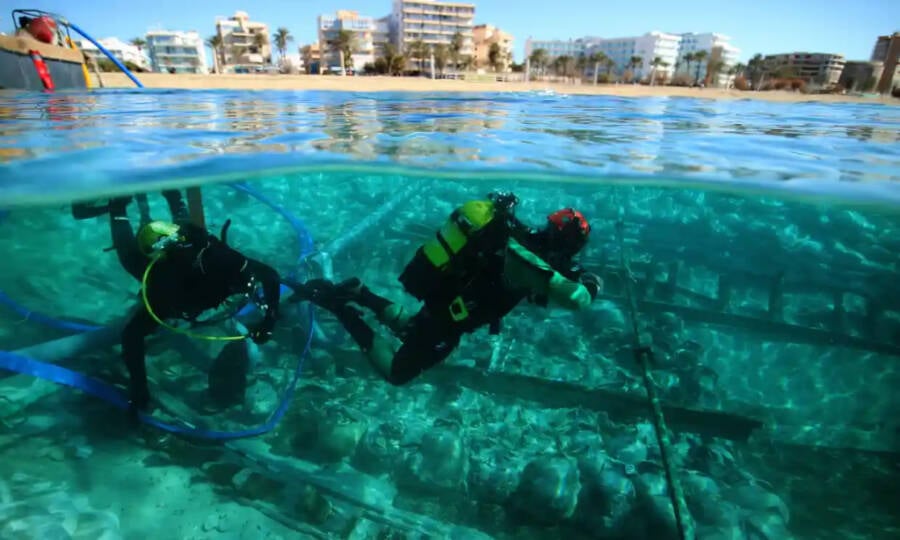The 4th-century Roman vessel sank off the coast of Mallorca, Spain while carrying containers of fish sauce, fruit preserves, olive oil, and wine. Now, a new study details both the ship's cargo and its building materials.

Arqueomallornauta/Consell de MallorcaSunken cargo from the 4th-century Roman ship.
A new study published in the journal Archaeological and Anthropological Sciences has provided details about the “unique” cargo of a 4th-century Roman shipwreck.
The 1,700-year-old ship, dubbed the Ses Fontanelles, was first discovered off the coast of Mallorca, Spain in 2019. Archaeologists have since removed several items from the wreckage, including over 300 amphora jars — some full of food provisions.
Now, the study has detailed the makeup of these items and even sheds light on ancient Roman maritime techniques to protect cargo.
Researchers Make An Intriguing Discovery Off The Coast Of Spain

Jose A. Moya/Arqueomallornaua/Consell de Mallorca,The dive team explores the shipwreck.
In 2019, a storm struck the coast of Mallorca, a Spanish island in the Mediterranean. The strong waves freed the wreckage of a 40-foot-long Roman ship near Ca’n Pastilla beach, bringing it to archaeologists’ attention.
Over the centuries, the ship had been preserved by layers of sediment that inevitably covered the ship, preventing it from being exposed to oxygen.
“The most surprising thing about the boat is just how well preserved it is — even the wood of the hull,” Dr. Miguel Ángel Cau, an archaeologist at the University of Barcelona, told The Guardian. “It’s wood that you can knock — like it’s from yesterday.”
Diving expeditions soon revealed the shipwreck to be unique. Not only was the Ses Fontanelles remarkably well-preserved, but it contained over 300 amphorae, or ancient Roman or Greek jars with narrow necks. In some of these jars, researchers found remnants of food. And many of them featured painted labels, or tituli picti, that gave descriptions of their contents.
“It’s incredibly difficult — almost impossible — to find whole amphorae that bear inscriptions, and also still have the remains of their contents,” Dr. Darío Bernal-Casasola, an archaeologist at the University of Cádiz, told The Guardian. “The state of conservation here is just amazing. And you have got all this in just 2 metres of water where millions of people have swum.”
Alongside the amphorae, researchers also found a carpenter’s drill for ship repairs and several personal items from the crew, including a leather shoe, a rope shoe, and an oil lamp bearing the symbol of the Roman moon goddess, Diana.
Now, the new study has revealed in-depth details about the wreck’s cargo.
Analyzing The Roman Ship’s Cargo

Archaeological and Anthropological SciencesAn amphora jar and the fish remnants found within it.
On March 21, 2024, researchers from three Spanish universities in partnership with the Consell de Mallorca published their findings about the Roman shipwreck.
Researchers determined that the ship contained four types of amphora filled with foods like fish sauce, wine, fruit preserves, and olive oil, including one type of amphora that had never been seen before. According to their analysis, the fermented fish sauce, or garum, came primarily from anchovies and sardines.
Researchers determined based on their analysis of the wreck’s contents that the boat likely departed from Cartagena, Spain. They also discovered residue from herbs and vines on the outside of the amphorae, suggesting the ship’s crew used plants as cushioning to protect the cargo on rough seas.
Analysis of the ship’s wood revealed that the Romans were highly selective over their building materials. The shipbuilders used pine for the main parts of the hull, while other pieces of the ship were cut from olive, laurel, and juniper.
“It’s important in terms of naval architecture because there are very few ancient boats that are as well preserved as this one,” Bernal-Casasola told The Guardian. “There are no complete Roman boats in Spain.”
Now, researchers are working to preserve the wreck so that more people will have the chance to see it.
“At the end of the day,” said Jaume Cardell, the Consell de Mallorca’s head of archaeology, “we do archaeology for everyone and not just for the scientists.”
After reading about this sunken Roman ship, dive into the history of who invented pizza. Then, read the story of the Picts, the ancient Celtic people who successfully held off a Roman invasion.





